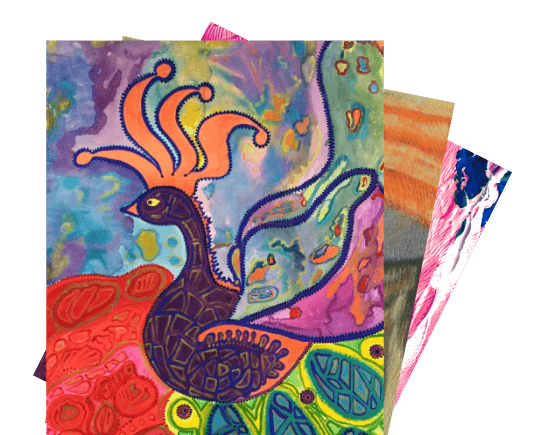Filters
Available Artwork
Showing 1–9 of 143 results
-
Mooltatva: Zindagi
$1,240
Watercolor on Paper
27 W x 38 H Inch
Deepika GH
India
-
Bhoot, Bhavishyat, Vartamaan
$970
Acrylic on Paper
30 W x 40 H Inch
Deepika GH
India
-
Prem Pyar
$1,150
Watercolor on Paper
27 W x 38 H Inch
Deepika GH
India
-
Manzil
$640
Acrylic on Canvas
18 W x 48 H Inch
Deepika GH
India
-
Gossip
$1,470
Acrylic on Canvas
36 W x 36 H Inch
Priyanka Shendage
India
-
Woman
$630
Acrylic on Canvas
28 W x 18 H Inch
Priyanka Shendage
India
-
Blooming
$730
Acrylic on Canvas
24 W x 24 H Inch
Priyanka Shendage
India
-
Radha
$630
Acrylic on Canvas
24 W x 18 H Inch
Priyanka Shendage
India
Other styles of paintings you may like
Origins of Material Painting:
Did you know that Earth's natural pigments were among the earliest materials used by ancient people? The ancient people used these natural pigments to develop paint. Material traces its history back to somewhat 100,000 years back. Humans would grind up earthen clays and minerals and mix them with a binder, such as honey, animal fats, urine, blood, or oil. They then applied them with fingers, brushes, or by blowing them through hollow bones, like today's airbrushes. They used to mark their territory with pigments, paint the walls, and try to tell stories through these artworks. Early painters who foraged earthen pigments could usually find red, orange, yellow, brown, black, white, and sometimes green as earthen pigments, but blues and purples were more elusive. Each culture employed a distinct technique to create blues and purples. Prehistoric people used manganese ore, the Egyptians used copper frits, the ancient Chinese ground up malachite and azurite, and the Etruscans ground up Lapis Lazuli stones. The blue is made from a specific type of ochre that turns blue when cooked in the oven.
The spread and development of artistic techniques across various ancient civilisations, including the Egyptians, Minoans, Greeks, and Romans, demonstrate a history of collaboration among artists. Egyptian tombs, crafted from limestone, were coated in plaster and then painted with a palette of six distinct colours: charcoal black, red ochre, yellow orpiment, brown ochre, blue azurite, and green malachite. Notably, King Tut was interred with a paint box containing powdered malachite, orpiment, and red ochre. To ensure the paint adhered effectively to the plaster, Egyptian artists mixed their pigments with binders such as egg, resin, or beeswax. Then, the Minoans developed the fresco technique, which involved painting directly onto wet lime plaster, significantly enhancing the artwork's durability. Later, the Greeks created lead white paint, a dominant white pigment that remained popular until titanium dioxide replaced it in the nineteenth century. However, lead-based paint was a source of health issues for painters and others for centuries. The Greeks also employed beeswax-based encaustic painting techniques for pictures and murals, many of which have lasted for centuries. Additionally, the Romans utilised Egyptian and Greek pigments, as well as red vermillion mined in Spain. Dyes made from plants were also used in artwork in the Mediterranean region. Madder made red dyes; saffron, turmeric, and pomegranate rind made yellow; and indigo made dark blue. Other colours could be mixed from these primary hues. The Middle Ages, Renaissance, and Modern periods introduced new materials, colours, and technologies. During the Middle Ages, egg tempera was a standard painting method where pigment was mixed with water and egg. To prevent cracking, artists used a technique called glazing, which involved applying transparent layers on top of the painting, resulting in a highly finished appearance. In the Renaissance, linseed oil revolutionised painting as it replaced egg-based tempera, allowing for richer colour blending and slower drying times, ushering in the golden age of oil painting. Natural mineral pigments were extracted from the Earth and shaped into sticks, which artists, including da Vinci, Michelangelo, and Rembrandt, used as chalks. With the Industrial Revolution, synthetic pigments and factory-made papers and canvases democratised art materials. The 20th century witnessed a dramatic expansion in material experimentation, encompassing plastic, spray paint, found objects, and digital tools—reflecting the rapid technological and cultural shifts of the era. Today, artists continue to explore both traditional materials, such as wood and stone, and contemporary mediums, including digital pixels, biodegradable fabrics, and even augmented reality. Each material chosen carries historical context, tactile meaning, and creative possibility.


















